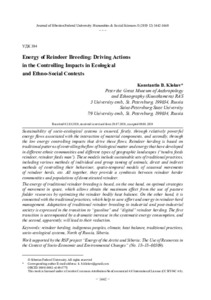Energy of Reindeer Breeding: Driving Actions in the Controlling Impacts in Ecological and Ethno-Social Contexts
Скачать файл:
URI (для ссылок/цитирований):
https://elib.sfu-kras.ru/handle/2311/112621Автор:
Klokov, Konstantin B.
Клоков, К. Б.
Дата:
2019-08Журнал:
Журнал Сибирского федерального университета. Гуманитарные науки. Journal of Siberian Federal University. Humanities & Social Sciences;2019 12 (8)Аннотация:
Sustainability of socio-ecological
systems is ensured, firstly, through relatively powerful
energy flows associated with the interaction of material components, and secondly, through
the low energy controlling impacts that drive these flows. Reindeer herding is based on
traditional patterns of controlling the flow of biological matter and energy that have developed
in different ethnic communities and different types of geographic landscapes (“tundra feeds
reindeer, reindeer feeds man”). These models include sustainable sets of traditional practices,
including various methods of individual and group taming of animals, direct and indirect
methods of controlling their behaviour, spatio-temporal
models of seasonal movements
of reindeer herds, etc. All together, they provide a symbiosis between reindeer herder
communities and populations of domesticated reindeer.
The energy of traditional reindeer breeding is based, on the one hand, on optimal strategies
of movement in space, which allows obtain the maximum effect from the use of pasture
fodder resources by optimizing the reindeer bodily heat balance. On the other hand, it is
connected with the traditional practices, which help to save effort and energy in reindeer herd
management. Adaptation of traditional reindeer breeding to industrial and post-industrial
society is expressed in the transition to “gasoline” and “digital” reindeer herding. The first
transition is accompanied by a dramatic increase in the systematic energy consumption, and
the second, apparently, will lead to their reduction Устойчивое функционирование социально-экологических
систем обеспечивается,
во‑первых, за счет относительно мощных потоков энергии, связанных
с взаимодействием материальных компонентов, во‑вторых, за счет имеющих слабую
энергетику управляющих воздействий, контролирующих эти потоки. Северное
оленеводство основано на традиционных моделях контроля потоков биологического
вещества и энергии, сложившихся у разных этнических общностей в различных типах
географических ландшафтов («тундра кормит оленя — олень кормит человека»). Эти
модели включают устойчивые наборы традиционных практик, в составе которых:
различные способы индивидуального и группового приручения животных, прямые
и косвенные методы управления их поведением, пространственно-временные
модели сезонных перемещений оленьих стад и др. В совокупности они обеспечивают симбиоз
между сообществами оленеводов и популяциями домашних оленей.
Энергетика традиционного оленеводства построена, с одной стороны,
на оптимальных стратегиях перемещений в пространстве, которая за счет
оптимизации теплового баланса организма оленя позволяет получить максимальный
эффект от использования кормовых ресурсов пастбищ. С другой стороны, она
связана с использованием традиционных практик, благодаря которым достигается
экономия труда и, следовательно, энергии, затрачиваемой пастухами на выпас оленей.
Адаптация традиционного оленеводства к индустриальному и постиндустриальному
обществу выражается в переходе к «бензиновому» и «цифровому» оленеводству.
Первый переход сопровождается резким увеличением общесистемных энергозатрат,
а второй, по-видимому, приводит к их снижению

